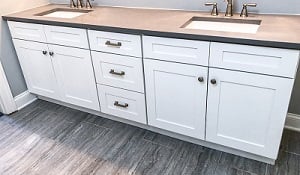
Bathroom flooring is a unique creature. Unlike the rest of the floors in a home, ones in the bathroom get exposed to not only moisture, but also humidity. Also, people using the floor are more likely to be barefoot, adding another layer of special consideration needed. While you want your floors to look good with your decor, you also want them to stay functional. When choosing bathroom flooring, it’s important to consider these features to ensure best performance.
Moisture Resistance
This one is the most obvious, but you’d be surprised how often it’s skimped on. Bathrooms are exposed to water more than any other room. Whether it’s wet feet after a shower, or an overflowed toilet, the flooring needs to be able to hold that moisture on the surface, not letting it seep into the subfloor and parts unseen. This applies to the material itself, which is why tile and vinyl are top bathroom picks. How the edges and spaces are sealed between the flooring and the supporting structures, like molding and subflooring, is also important. Ideal floor performance comes from constructing a floor that is as impervious to water as possible, using proper flooring material, grout, and caulking when needed.
Solid Subfloor
The subfloor material should be of high concern. It is important because the subfloor needs to be able to withstand the high moisture levels in a bathroom, and not all materials can handle such a tremendous task. The subfloor prevents water from seeping into areas around the sink, toilet, and bathtub, which are more prone to exposure to water. By choosing the right material from the start, your bathroom will stand a better chance of withstanding long-term damage. Excess moisture in the subfloor is a common reason for early replacement of bathroom flooring. This can be prevented by choosing the right material from the beginning.
Exterior grade plywood is often a good fit due to its high level of moisture resistance. However, it is still a wood byproduct that, over time, runs the risk of warping and swelling. Proper installation of cement-based backer board using mortar can help prevent this.
Durability
Durability is an important feature since we’re combining a moist environment and a high traffic area. You need a surface that is easy to clean, but also safe to walk on with bare, wet feet. The three most durable options are porcelain or ceramic tile, vinyl, or natural stone. All of these come in a wide range of options and will stand up to most anything you can throw at them.
What to Avoid
Not all flooring is created equal when it comes to the bathroom. Avoid hardwood and carpet, unless they are specially designed for the bathroom. Real hardwood floors have the potential to absorb a significant amount of moisture in the bathroom, causing the board to warp and rot. You can choose an engineered hardwood as an alternative with a similar look, but better performance. Or, if you must have hardwood, you need to have an installer you trust to ensure its installed perfectly, with zero moisture gaps. If carpet is your must-have, ensure it’s 100% inorganic, the pile is low, and the padding is waterproof.
Ensure Your Bathroom Outperforms
Let performance, durability, and style determine which flooring you choose for the bathroom. Regardless of material choice, installation is the key to a lasting bathroom flooring job. BECK America has the tools and fasteners you need to construct floors that last, in particular SCRAIL® SubLoc® PRO which is designed with aggressive double threads for squeak-less subfloor installation. Learn the value of a secure subfloor in our download by clicking below.
.svg.png)
